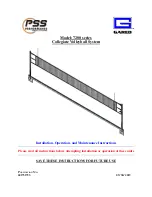
1—7
Page 4
1 - 7 Fig 2 - VHF Control Unit
1 - 7 Fig 2 - VHF Control Unit
VHF Control Unit
6. The control unit (marked VHF COMM) (Fig 2), is installed on the
right cockpit wall at the Co-pilot’s position. It has two rotary frequency
selector knobs with an associated 6-digit mechanical frequency display,
a rotary VOLume control knob, an ON/off toggle power switch and a TST
(test) button. The left-hand frequency knob selects 1.0 MHz steps and
the right-hand knob selects 0.025 MHz steps. The ON/off switch controls
the power supply to the system. The VOLume knob controls the level of
the audio input to the Pilot’s headset. The TST button is used to disable
the squelch circuit. When pressed, increased noise should be heard
in the headphones in the absence of a speech signal, thus providing a
confidence check on receiver operation.
Note
: Transmissions may cause interference to the ILS localiser and
PTR 1751WW V/UHF signals.
V/UHF Radio
7. A PTR 1751WW V/UHF radio is fitted and controlled either from a
unit on the left wall beside the Pilot or by a control unit on the Navigator’s
table (Fig 3). A switch (marked PILOT/NAV) beside the Navigator’s
control unit selects the operative control unit. Preset channels cannot
be selected from the Pilot’s control.
8. The V/UHF equipment consists of three units, the transceiver and two
control units. The transceiver provides voice communication on 7000
channels from 118.0 to 136.975 MHz and 225 to 399·975 MHz at 0·025
MHz spacing. Up to 30 channels can be preset and stored in the non-
volatile memory. Access to preset channels is by means of a single rotary
switch. Additionally, the UHF and VHF guard channels can be selected by
either setting the mode switch to GU or GV respectively, for transmit and
receive purposes or by selecting the function switch to TR+G to monitor
243 MHz (only) in addition to the manually selected frequency.
UNCONTROLLED DOCUMENT - NOT FOR USE IN FLIGHT OR TO BE PRINTED
UNCONTROLLED DOCUMENT - NOT FOR USE IN FLIGHT OR TO BE PRINTED
















































